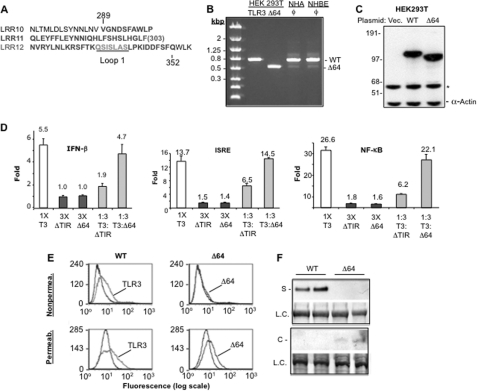FIGURE 6.
The TLR3 isoform Δ64. A, shown is the sequence affected in the Δ64 isoform. The sequences in LRR 10–12 are shown, and the sequence deleted in Δ64 is in bold. The Phe-303 residue that is substituted in the F303S SNP and the Loop 1 sequence are in grey and underlined. B, expression of Δ64 isoform in NHA cells and NHBE cells is shown. The gel shows the results of an RT-PCR reaction separated by agarose gel electrophoresis and visualized by staining with ethidium bromide. The HEK293T cells transfected with constructs expressing WT TLR3 or Δ64 served as positive controls. The cDNAs were generated from polyadenylated RNAs primed with oligo(dT) and random hexamer primers (supplemental Table S1) as described by Yang et al. (23) for PCR. C, the overexpression of Δ64 protein in HEK293T cells is shown. Plasmids encoding the wild-type TLR3 and Δ64 were transiently transfected to HEK293T cells. The Western blots were probed with a mixture of two mAbs, one to detect TLR3 and a second to detect α-Actin. The latter signal was intended as the internal loading controls. A nonspecific band recognized in Western blots is identified with an asterisk. D, the Δ64 isoform is defective for activation of reporter gene expression. Three independent luciferase reporters were used, as driven by the INFβ, ISRE, and NF-κB promoter elements. Whether the isoform was able to act as a dominant negative mutant to the wild-type TLR3 was also examined by transfecting into cells a 3 m excess of the isoform expression plasmid relative to the wild-type TLR3. In these assays the bona fide dominant negative mutant, ΔTIR, was used as a control. E, FACS analysis of the cell surface (Nonpermea.) and total (Permeab.) TLR3, TLR3 Δ64. The data forTLR3 and Δ64 are identified. The black lines show the sample stained with a control antibody to mouse IgG conjugated with phycoerythrin. F, Western blots to detect the secretion of T3ECDΔ64 are shown. S denotes the secreted form of T3ECD. The loading controls (L.C.) were taken from the same membrane used for Western analysis.

